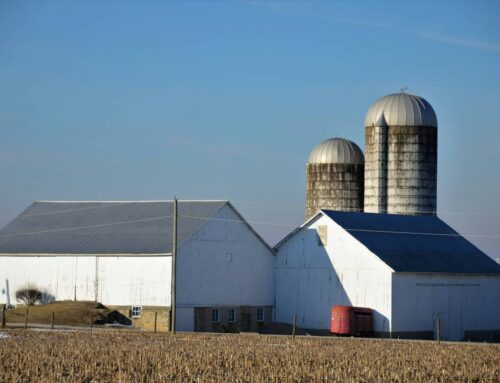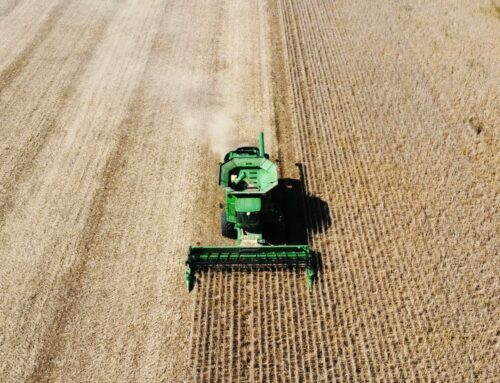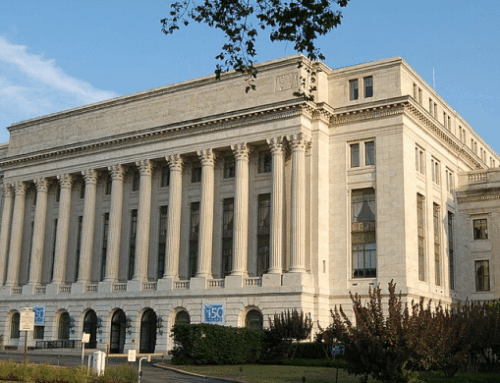Report
Fiscal Benefits for Strengthening Conservation Compliance
Conservation standards must be updated to ensure accountability to the taxpayer.
Read the full report as a PDF.
In 1985, President Reagan signed a farm bill that included a provision requiring participants in federal agriculture income subsidy programs to undertake certain common sense steps aimed at wetlands preservation and soil erosion prevention.
- Since its inception in 1985, conservation compliance has successfully reduced soil erosion and conserved wetlands.
- More effective conservation compliance standards could help reduce significant consumer and taxpayer costs tied to risky agricultural production decisions.
- With conservation compliance standards now over 30 years old, it is time to revisit them to better ensure that taxpayer subsidies are not being used to incentivize risky production practices or cause unintended consequences and costs for everyone.
At the time, federal farm safety net programs came with few strings attached, resulting in taxpayers bearing the financial risks for some producers that chose to expand cropland acreage by draining wetlands, plowing native grasslands, or operating on highly erodible land (HEL). Under this new “conservation compliance” requirement, however, a quid pro quo was enacted. In order to participate in income safety net programs, agricultural producers were prohibited from draining wetlands (known as “Swampbuster”) and could only plant on HEL acreage after crafting a conservation plan in conjunction with USDA’s Natural Resources Conservation Service. In the 30 years since enactment, significant environmental gains (such as reductions in soil erosion) have occurred,[1] and a majority of farmers agree that best management practices should be tied to farm subsidy eligibility requirements (see figure to the right from the Environmental Working Group).[2] Building on this success and support from farmers, the 2014 Farm Bill made conservation compliance requirements a condition for participation in the federally subsidized crop insurance program—a requirement that had been severed in 1996.
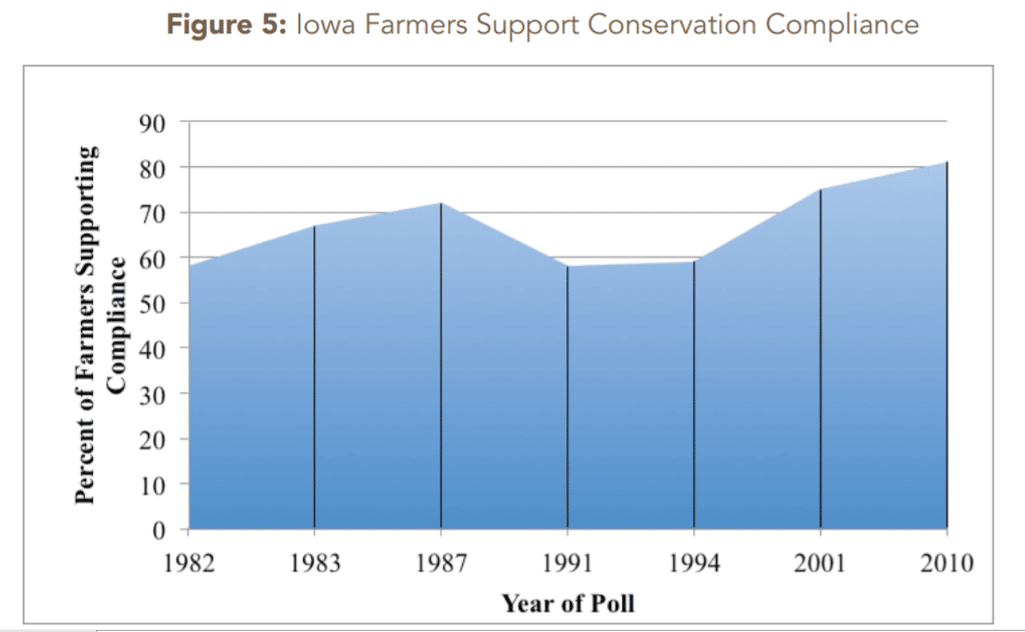
However, as several independent analysts have documented, these standards are not being implemented, monitored, and enforced equitably across the country. This has resulted in the underlying conservation standards being rendered meaningless in certain states and counties, meaning taxpayers bear the financial risks associated with economically risky and environmentally damaging planting decisions, such as draining wetlands and converting native grasslands to subsidized crops such as corn and soybeans. These impacts result in greater soil erosion, water pollution, greenhouse gas (GHG) emissions, and other negative consequences which increase costs for both consumers and taxpayers. If conservation compliance standards are to effectively conserve wetlands and limit soil erosion, while reducing costs for federal programs, they must be updated to reflect today’s economic conditions and be effectively implemented and enforced.
Otherwise, agricultural income subsidies will continue to work at cross-purposes with other federal programs and waste taxpayer dollars in the process.Mechanics of Conservation Compliance
Producers of most major U.S. crops are potentially subject to conservation compliance standards given their participation in one or more federal farm safety net programs. Most producers of livestock forage crops – such as pasture and alfalfa – are not required to implement conservation plans (since they generally do not receive taxpayer subsidies, aside from a small number of acres enrolled in the Federal Crop Insurance Program). However, given that only certain types of land require conservation plans (for HEL in particular, in addition to conserving wetlands), the percentage of farm land actually impacted by the requirement is much smaller. Details of the requirements include the following:
- Types of subsidy payments: Conservation compliance is a condition of several farm bill programs – including Agriculture Risk Coverage (ARC), Price Loss Coverage (PLC), marketing loans, and conservation and disaster payments, in addition to crop insurance subsidies (as of the 2014 farm bill). ARC makes payments when a producer’s average revenue falls slightly below levels experienced in recent years. PLC sends payments when commodity prices fall below a reference price mandated by the federal farm bill, the law governing farm subsidies. Together, ARC and PLC are available to farm bill-defined “covered commodities” including corn, soybeans, wheat, rice, oats, barley, grain sorghum, pulse crops, peanuts, and other oilseeds. While cotton is no longer a covered commodity, cotton producers are often subject to conservation compliance because they obtain marketing loans and possess generic base acreage on which other covered commodities are grown. Finally, under federal crop insurance agricultural businesses can purchase subsidized insurance policies guaranteeing either expected yields or revenue.[3] In 2009, “23 percent of farms (accounting for 71 percent of cropland) received commodity payments”[4] (which now encompass ARC, PLC, and marketing loans) and over 80 percent of harvested cropland acres were enrolled in crop insurance in 2012.[5] Hence, most farmland is subject to the accountability requirements if the land contains a wetland or is highly erodible.
- Wetlands conservation (Swampbuster): Swampbuster regulations are intended to deny federal subsidies to producers who converted wetlands to cropland after 1985, unless an exemption applies.[6] The U.S. Department of Agriculture (USDA) estimated that “12.9 million acres of wetland[s] were directly adjacent to existing cropland,”[7] and hence may be affected by Swampbuster regulations.
- Highly erodible land (HEL): About 25 percent of U.S. cropland (100 million acres) is categorized as “highly erodible,” and “85 percent of this land is subject to conservation compliance through subsidy eligibility.”[8] (See map below from USDA’s Economic Research Service (ERS)).[9] HEL is prevalent in states such as Kansas, Nebraska, Texas, Iowa, North Dakota, and Montana. These states also happen to have the highest crop insurance indemnities, meaning that taxpayers are subsidizing planting on land with a high risk of crop loss.[10] The HEL requirements may be met with several different conservation practices given that USDA’s final program regulations were less strict than originally envisioned. In fact, more than 50 percent of acres are only required to have conservation plans on file with USDA stating that they will use no-till practices and manage crop residues, practices that many would implement anyway.[11] Grassed buffers, terraces, and other conservation practices that help further reduce soil erosion and water pollution are not required and thus are not as widely utilized.
- Sodsaver: A more geographically limited provision in the 2014 farm bill also reduced crop insurance premium subsidies for producers planting insurable crops on native sod. However, the limitation only applies to acres in MN, IA, ND, SD, MT, and NE.[12]
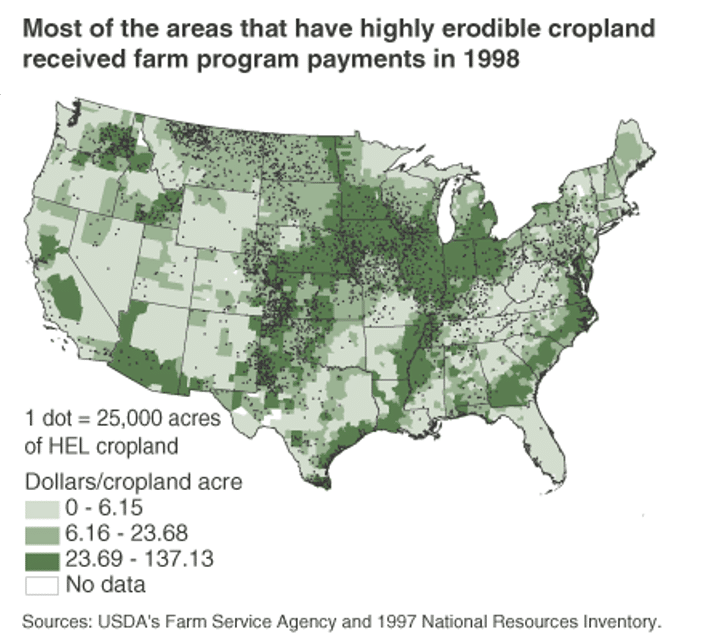
Fiscal and Environmental Benefits of Conservation Compliance
Since its inception in 1985, conservation compliance has successfully reduced soil erosion and conserved wetlands. According to USDA-ERS, between 1982 and 2012, soil erosion on cultivated cropland declined by 45 percent, from 2.9 billion tons in 1982 to 1.6 billion tons in 2012.”[13] Much of the erosion gains occurred in the years immediately after conservation compliance implementation. USDA found that “296 million tons of soil erosion reduction occurred on land subject to conservation compliance, or about 40 percent of soil erosion reduction on highly erodible cropland and 25 percent of all soil erosion reduction.”[14] The remaining HEL soil erosion reductions (40 and 20 percent, respectively) were tied to acres in the Conservation Reserve Program, a land set-aside program, and other HEL acres that are not subject to compliance (since they do not receive farm subsidy payments with conservation accountability requirements attached).[15] In addition, the Swampbuster standards helped reduce wetland drainings from “235,000 acres per year before 1985 to 27,000 acres per year from 1992 through 1997,” protecting 1.5 to 3.3 million acres of wetlands.[16]
At least in theory, this quid pro quo results in taxpayer subsidies being contingent upon producers meeting certain basic soil and water conservation standards. If producers are not implementing best management practices, regulations are in place to send their subsidies back to taxpayers. This way, taxpayers get a better return on their investment instead of subsidies working at cross-purposes with other federal programs aimed at improving air, water, and soil quality. If strengthened and implemented properly, conservation compliance can help reduce soil erosion, conserve wildlife habitat, build soil carbon, reduce GHG emissions, improve both local and downstream water quality, and enhance recreational opportunities. These benefits result in billions of dollars in lower water treatment costs, less bottled water purchases, better public health, and improved economic opportunities for industries relying on clean water such as fishing, boating, etc.
While conservation compliance currently does not specifically require producers to implement practices to improve water quality by reducing nitrogen fertilizer runoff that leads to water pollution, for instance, requirements could be updated to better reflect current market realities and agricultural production practices. For instance, as USDA-ERS has noted, high cropland prices from 2007-13 may have incentivized farmers to plow up more sensitive acres such as native grasslands and drain more wetlands, despite conservation compliance requirements.[17] While some price increases were caused by the 2012 drought limiting crop supplies, the availability of commodity, biofuels, and crop insurance subsidies also reduces risks that producers face, resulting in taxpayers subsidizing agricultural production on risky acres without effective monitoring and enforcement of conservation compliance standards (see next section for more details).
When producers increased corn planted acres, for instance, after record $8-per-bushel corn prices in 2012, millions of acres of native grasslands and wetlands were lost as corn acres reached record levels of over 90 million acres. Because corn is one of the most input-intensive crops, nitrogen fertilizer applications also increased with those new acres. To make matters worse, USDA-ERS estimates that two-thirds of U.S. cropland acres do not meet best management criteria for nitrogen fertilizer applications.[18] When nitrogen leaches through the soil via underground tile drains and eventually into nearby waterways, not to mention wind and water erosion,[19] it eventually pollutes water that Americans rely on for drinking water, fishing, recreation, and other industries. While conservation compliance requirements have historically focused on reducing soil erosion and the draining of wetlands, they also indirectly affect the amount of pollutants entering water supplies. In a 2010 poll, 70 percent of Iowa farmers indicated they would support conservation accountability standards being extended to address nutrient/fertilizer runoff problems in addition to limiting erosion on HEL and protecting wetlands.[20]
If updated to reflect current realities, more effective conservation compliance standards could help reduce significant consumer and taxpayer costs tied to risky agricultural production decisions. Just a few of the costs that could be mitigated with more widespread use of effective best management conservation practices include the following, not to mention better long-term productivity of the land which improves producers’ bottom lines:
- Taxpayer costs: The Government Accountability Office (GAO) estimated in 1999 that 35 different federal programs have spent tens of billions of taxpayer dollars addressing nonpoint source pollution (such as nitrogen fertilizer runoff from cropland).[21] USDA also administers farm bill conservation programs aimed at reducing the negative environmental impacts of agricultural production, which total approximately $6 billion each year.
Enough is Enough Says Des Moines Water Works
– Des Moines Water Works, the water utility in Des Moines, IA, sued three nearby counties for failing to reduce nitrogen fertilizer runoff from cropland fields.
– In May 2017, the utility announced plans to spend $15 million to upgrade and expand its facility to remove unhealthy levels of nitrates from drinking water.
– In 2015, a record $1.5 million was spent removing unsafe levels of nitrates from Des Moines residents’ water supplies.
- Drinking water: Billions of dollars are spent each year by consumers, water utilities, and taxpayers to remove agricultural pollutants from water so it is safe enough to drink. A USDA study estimated consumers spend $1 billion each year on bottled water due to nitrate water pollution.[22] Another USDA study from 2011 concluded that the “cost to all public and private sources of removing nitrate from U.S. drinking water supplies… is over $4.8 billion per year.”[23] The problem with nitrate pollution is worst in agricultural areas, with the National Institutes of Health (NIH) estimating in 2008 that over one-fifth of private wells have dangerous levels of nitrates in their water, “in contrast to less than five percent of public water supplies.”[24] Pollution from herbicides and insecticides also increases consumers’ drinking water costs: a 1992 study estimated the cost to remove atrazine from drinking water in 11 small communities would total $8.3 million in capital costs, plus $180,000 in annual operating costs.[25]
- Public health: The legal limit for nitrates in drinking water is 10 mg/l, as set by the Environmental Protection Agency. Not only have hundreds of municipal water systems have failed to meet federal guidelines, but even the maximum allowed level of 10 mg/l is dangerous to certain populations. High nitrate levels in drinking water may cause infants to suffer from methemoglobinemia, known as blue baby syndrome, “which prevents the transport of sufficient oxygen in the bloodstream”[26] and may even lead to death.
Valuing Benefits from Healthy Ecosystems
– While it is difficult for researchers to project the financial benefits that healthy ecosystems provide (since many are not traded on markets), a World Resources Institute study estimated the value of global ecosystems at $33 trillion.
– The Ohio River Basin Trading Project is an example of a “payments for ecosystems” services program that aims to quantify water quality benefits arising from lower phosphorus and nitrogen pollution. The market-based approach, which began in 2014 in IN, OH, and KY, allows utilities to purchase nutrient reductions from farmers to reduce their cost of treating polluted water.
- Gulf of Mexico dead zone: According to Iowa State researchers, “the evidence is overwhelming that extensive Gulf hypoxia would not occur if all farm-applied nutrients stayed on the farm and were used by crops or were stored in wetlands or other natural sinks.”[27] Hypoxia occurs when excessive amounts of nitrogen fertilizer run off fields, enter nearby waterways, and eventually make their way to the Mississippi River and the Gulf of Mexico where aquatic life is deprived of oxygen due to excessive algae growth. Iowa State explains that “agriculture is the largest contributor of non-point [nitrogen] losses” that harm the Gulf and industries relying on clean water. For instance, the $650 million/year Gulf fishing industry suffers when, as one study estimated, up to one-fourth of Louisiana’s shrimp habitat is lost due to Gulf hypoxia.[28]
- Recreation, navigation, etc.: The water quality benefits of reducing sediment damage from agricultural erosion have been estimated at $2-$8 billion per year (in 1989 dollars), including benefits for “navigation, reservoirs, recreational fishing, water treatment, water conveyance systems, and industrial and municipal water use.”[29] Benefits to recreation include those for fishing, boating, and swimming.[30] Other studies found similar water quality benefits – over $4 billion per year – if erosion was better controlled on U.S. cropland.[31]
Enforcement Failures Lead to Wasted Taxpayer Dollars
While conservation compliance standards were successful in reducing soil erosion decades ago, independent analysts have found that current standards have not been effectively implemented and enforced as required by law. Without the threat of losing subsidies, some producers engage in risky production practices (such as draining wetlands) that occur at taxpayer expense. Both USDA’s Office of Inspector General (OIG) and GAO have concluded that the standards are enforced inconsistently from county to county, and taxpayer subsidies have been paid to farmers even though they have failed to meet the basic best management practices. Just a few of these reports’ findings include the following:
- Ineffective implementation: A 2003 GAO report found that half of local USDA Natural Resources Conservation Service (NRCS) offices were failing to implement the law as required.[32]
- Weak standards: Of the nearly 300 conservation plans that were examined in 1991, OIG determined that 86 percent did not meet USDA’s technical requirements.[33]
- Failure to utilize penalties: USDA only applies a graduated penalty to a few percent of farms despite more widespread noncompliance.[34]
- Lack of field checks: OIG found that USDA is not conducting an adequate number of field status reviews in a timely fashion, in addition to ineffective recordkeeping about whether farmers were complying with the basic standards.[35]
- Waste of taxpayer dollars: A 1995 OIG report found “$212,000 in farm program benefits [were paid out] even though estimated soil erosion exceeded the acceptable level.”[36] And even when the Farm Service Agency withheld $125 million in subsidies for 2002-06 violations, 83 percent of these funds were later reinstated.[37] GAO found similar results from 1993 and 2001 when 5,084 farms and 7,187 farmers were found out of compliance, but instead of $42 million being returned to taxpayers, only 20 percent was denied.[38]
- Impact of high crop prices: ERS noted that the “rise in commodity prices…[from 2007-13] reduced… incentives for meeting compliance requirements.”[39]
For these reasons, “in 2007, USDA’s National Resources Inventory (NRI) data shows [that] 54 million acres of highly erodible land had estimated soil losses above the tolerance or “t” level (the highest level that can be sustained without threatening long-term soil productivity)” in addition to 48 million acres of non-highly erodible with unsustainable rates of soil erosion.[40] In states like Iowa, the soil erosion rate has actually increased in recent years with record plantings of corn and other crops. The Environmental Working Group and the Iowa Daily Erosion Project at Iowa State University estimate millions of Iowa cropland acres have unsustainably high soil erosion rates without even accounting for erosion from gully runoff (narrow bands in hilly fields that fill with water during heavy rains). In nearby Nebraska, USDA recently announced that it will start requiring farmers to install additional conservation practices – such as grassed buffers, terraces, etc. – on highly erodible land with gullies to combat problems with soil erosion and water pollution.[41] In the past, conservation practices were only required if erosion wa
s found to cause downstream damages. Without all states and counties enforcing the minimal soil and wetland standards consistently and effectively, farmers will continue to reap generous subsidies while causing downstream costs and additional burdens for taxpayers and the public.Recommendations
With conservation compliance standards now over 30 years old,[42] it is time to revisit them to better ensure that taxpayer subsidies are not being used to incentivize risky production practices or cause unintended consequences and costs for everyone from residents in Des Moines, IA, to fishermen in the Gulf of Mexico. Not only should Congress ensure that soil and wetland conservation requirements are met, but farm subsidy accountability standards should also be expanded to address current environmental challenges. Otherwise, federal agriculture subsidies will continue to work at cross purposes with other federal programs aimed at protecting water, air, soil, and wildlife habitat. The next farm bill must prioritize the following principles/recommendations to ensure farm subsidies are more accountable to taxpayers:
- Updated to reflect current economic and farming conditions: Not only were HEL and wetlands conservation requirements created in 1985, but their implementation has been watered down over time. In addition, the availability of generous farm subsidies and high crop prices in recent years altered the landscape, resulting in producers draining wetlands and tearing up native grasslands to plant subsidized crops such as corn and soybeans. Updated accountability standards should reflect these new realities and the high taxpayer and consumer costs that have resulted from producers attempting to maximize short-term profits (and subsidies) at the expense of long-term productivity. For instance, significant soil erosion from gullies should be better addressed in all states. They should also ensure that unintended consequences do not result from certain regulations being in place, such as greater use of herbicides with more widespread use of no-till methods, for instance, as GAO has warned.[43]
- More effective monitoring and enforcement: More effective monitoring and enforcement of conservation compliance standards would ensure that taxpayer dollars are not causing downstream liabilities for taxpayers and consumers. A dedicated stream of funding for monitoring and enforcement should be provided to USDA so recommendations from independent analysts such as USDA-OIG and GAO can be implemented. Spot checks must also increase from less than one percent of fields to at least the previously required five percent.[44]
- Expansion to non-HEL acres: Accountability standards should be expanded to all acres receiving taxpayer subsidies, not just those that are highly erodible or near wetlands, since unsustainable levels of soil erosion and other environmental challenges are found on tens of millions of acres not covered by the current standards. Opportunities to improve soil retention, build soil carbon, and reduce water pollution are present on these other acres as well, particularly on fields that contribute to water quality problems in the Mississippi River and Gulf of Mexico.
- Farm subsidy reform: Underlying agriculture subsidies that distort markets and promote risky planting decisions should also be reformed. The resulting safety net – one that steps in only during times of true need such as major floods and droughts – should be tied to more effective conservation compliance standards.
If these recommendations are implemented, not only will taxpayer dollars be spent more wisely, but agricultural producers will also be more productive in the long-run. Other incentive structures could also be considered in the long-term, such as shifting U.S. agricultural subsidies toward performance-based payments which are more cost-effective than the current system which is largely based on paying for certain practices to be implemented in conservation programs, plus attaching accountability standards to farm subsidy payments.[45] In other words, the more improvements a producer makes to his or her field and the greater public benefits, the larger the payment. In addition, instead of a “stick” approach with conservation compliance standards, a “carrot” approach could be more widely used to incentivize greater return on taxpayers’ investment in agriculture. These reforms fit beneath an overarching goal of creating a more cost-effective, transparent, accountable, and responsive farm safety net, one that reduces – instead of increases – our nation’s $20 trillion and growing national debt.
For more information, visit www.taxpayer.net, or contact Joshua Sewell at josh at taxpayer.net.
Footnotes
[1] http://www.ewg.org/research/conservation-compliance
[2] http://static.ewg.org/pdf/conservation_comp_maxs.pdf?_ga=1.180451047.1373537909.1481568681
[3] https://www3.rma.usda.gov/apps/sob/current_week/insplan2016.pdf
[4] https://www.ers.usda.gov/webdocs/publications/44666/16471_eib94_2_.pdf?v=41055
[5] https://www.agcensus.usda.gov/Publications/2012/Online_Resources/Highlights/Farms_and_Farmland/Highlights_Farms_and_Farmland.pdf, https://www3.rma.usda.gov/apps/sob/current_week/sobrpt2004-2013.pdf
[6] https://www.nrcs.usda.gov/wps/portal/nrcs/detailfull/national/water/wetlands/?cid=stelprdb1043554
[7] https://www.ers.usda.gov/webdocs/publications/44666/16471_eib94_2_.pdf?v=41055
[8] https://www.ers.usda.gov/webdocs/publications/44666/16471_eib94_2_.pdf?v=41055
[9] https://wayback.archive-it.org/5923/20120620204925/http://www.ers.usda.gov/AmberWaves/June04/Features/HaveConservation.htm
[10] https://www.rma.usda.gov/data/indemnity/2017/2016_042417map.pdf
[11] https://wayback.archive-it.org/5923/20120620204925/http://www.ers.usda.gov/AmberWaves/June04/Features/HaveConservation.htm
[12] https://www.everycrsreport.com/reports/R42459.html
[13] https://www.ers.usda.gov/webdocs/publications/84457/err-234.pdf?v=42942
[14] https://www.ers.usda.gov/webdocs/publications/44666/16471_eib94_2_.pdf?v=41055
[15] https://www.ers.usda.gov/webdocs/publications/44666/16471_eib94_2_.pdf?v=41055
[16] https://www.nrcs.usda.gov/wps/portal/nrcs/detailfull/national/water/wetlands/?cid=stelprdb1043554
[17] https://www.ers.usda.gov/webdocs/publications/44666/16471_eib94_2_.pdf?v=41055
[18] https://www.ers.usda.gov/amber-waves/2011/september/nitrogen-footprint/
[19] https://www.ers.usda.gov/amber-waves/2011/september/nitrogen-footprint/
[20] http://static.ewg.org/pdf/conservation_comp_maxs.pdf?_ga=1.180451047.1373537909.1481568681
[21] https://www.ers.usda.gov/webdocs/publications/41964/30288_waterquality.pdf?v=41143
[22] https://www.google.com/url?sa=t&source=web&rct=j&url=http://www.ucsusa.org/sites/default/files/attach/2016/08/Subsidizing-Waste-full-report.pdf&ved=0ahUKEwiem6GXuJPWAhVF3IMKHV2aD34QFghOMAU&usg=AFQjCNHosnGhDR4nfvE8Y9iDUY_H9yroYQ
[23] https://www.epa.gov/sites/production/files/2015-10/documents/htf_report_to_congress_final_-_10.1.15.pdf
[24] https://www.ncbi.nlm.nih.gov/pmc/articles/PMC3068045/
[25] https://www.ers.usda.gov/webdocs/publications/41964/30288_waterquality.pdf?v=41143
[26] https://www.ers.usda.gov/webdocs/publications/41964/30288_waterquality.pdf?v=41143
[27] http://www.card.iastate.edu/iowa_ag_review/fall_08/article4.aspx
[28] http://www.card.iastate.edu/iowa_ag_review/fall_08/article4.aspx
[29] https://www.ers.usda.gov/webdocs/publications/41964/30288_waterquality.pdf?v=41143
[30] https://www.ers.usda.gov/webdocs/publications/41964/30288_waterquality.pdf?v=41143
[31] https://www.ers.usda.gov/webdocs/publications/41964/30288_waterquality.pdf?v=41143
[32] http://static.ewg.org/pdf/conservation_comp_maxs.pdf?_ga=1.180451047.1373537909.1481568681
[33] http://static.ewg.org/pdf/conservation_comp_maxs.pdf?_ga=1.180451047.1373537909.1481568681
[34] http://static.ewg.org/pdf/conservation_comp_maxs.pdf?_ga=1.180451047.1373537909.1481568681
[35] http://static.ewg.org/pdf/conservation_comp_maxs.pdf?_ga=1.180451047.1373537909.1481568681
[36] http://static.ewg.org/pdf/conservation_comp_maxs.pdf?_ga=1.180451047.1373537909.1481568681
[37] http://static.ewg.org/pdf/conservation_comp_maxs.pdf?_ga=1.180451047.1373537909.1481568681
[38] http://static.ewg.org/pdf/conservation_comp_maxs.pdf?_ga=1.180451047.1373537909.1481568681
[39] https://www.ers.usda.gov/webdocs/publications/44666/16471_eib94_2_.pdf?v=41055
[40] http://static.ewg.org/pdf/conservation_comp_maxs.pdf?_ga=1.180451047.1373537909.1481568681
[41] https://www.nrcs.usda.gov/wps/portal/nrcs/detail/ne/newsroom/releases/?cid=NRCSEPRD1317211
[42] http://static.ewg.org/pdf/conservation_comp_maxs.pdf?_ga=1.180451047.1373537909.1481568681
[43] http://static.ewg.org/pdf/conservation_comp_maxs.pdf?_ga=1.180451047.1373537909.1481568681
[44] http://static.ewg.org/pdf/conservation_comp_maxs.pdf?_ga=1.180451047.1373537909.1481568681
[45] https://www.ers.usda.gov/webdocs/publications/eb5/29515_eb5_002.pdf
Related Posts
Most Read
Recent Content
Our Take
Dec 19, 2025 | 7 min readOur Take
Dec 17, 2025 | 5 min read
Stay up to date on our work.
Sign up for our newsletter.
"*" indicates required fields



